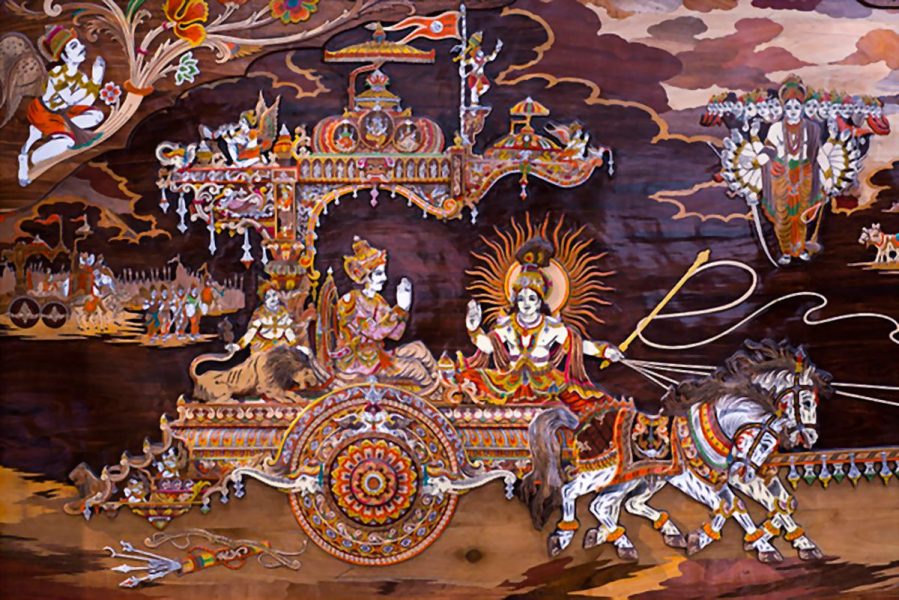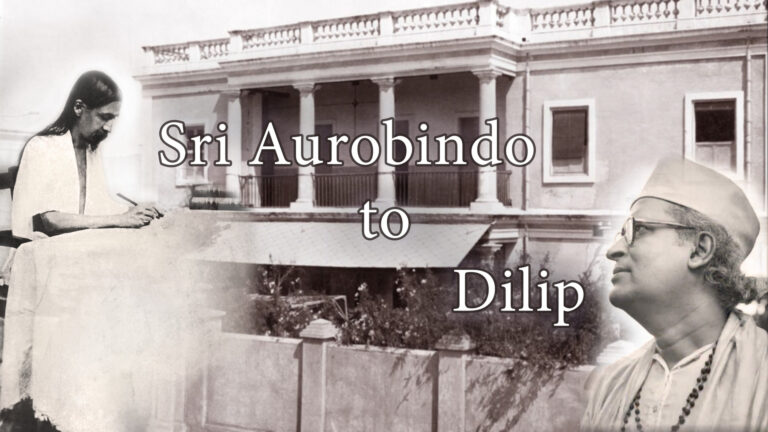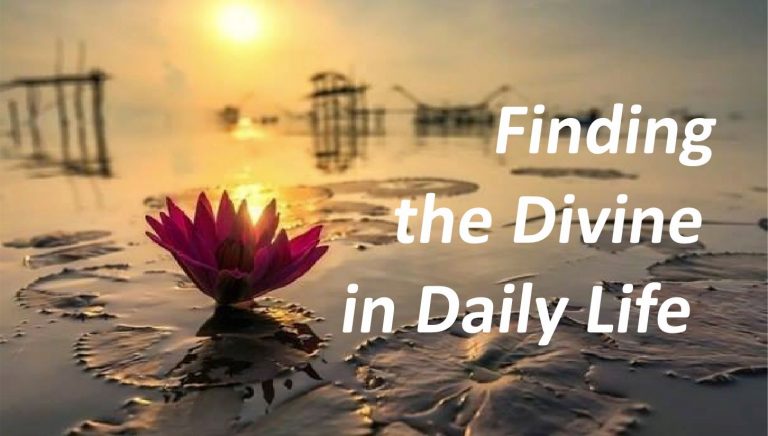 Arjuna comes next in the line of great characters in the Mahabharata. He is the hero on the battlefield of Kurukshetra and most importantly the recipient of the great teaching of the Gita directly from Sri Krishna. His qualification is very simply that he has stood with Sri Krishna from age to age in the great battle of the future not shrinking from action rather working together for the consummation of the Divine Will in humanity. He has forgotten his previous births but the Lord remembers and hence he is the chosen hero of a great plot that is going to change Time and usher in a New Age for mankind. In his personality he represents the rajo-sattwic man, the kinetic dynamic man who is moved not so much by personal ambition and desire as much as by higher and nobler ideals. He is the “srestha”, the true Aryan in spirit and deeds. In his personal evolution he has arrived at a high point wherein he can go beyond the circle of “trigunatmic prakriti “, the threefold modes of nature called as tamas, rajas, sattwa and find himself completely one with the Lord, living in Him forever and doing His deeds in the world. He is the “Kshatriya “, the warrior of a high and noble type like the knights and the Samurai who do not fight for personal gains but for defending the honour of their people and their country, for protecting the helpless and the weak, for taking on the strong Rakshasa and stand up against the forces of injustice and evil that oppresses the world.
Arjuna comes next in the line of great characters in the Mahabharata. He is the hero on the battlefield of Kurukshetra and most importantly the recipient of the great teaching of the Gita directly from Sri Krishna. His qualification is very simply that he has stood with Sri Krishna from age to age in the great battle of the future not shrinking from action rather working together for the consummation of the Divine Will in humanity. He has forgotten his previous births but the Lord remembers and hence he is the chosen hero of a great plot that is going to change Time and usher in a New Age for mankind. In his personality he represents the rajo-sattwic man, the kinetic dynamic man who is moved not so much by personal ambition and desire as much as by higher and nobler ideals. He is the “srestha”, the true Aryan in spirit and deeds. In his personal evolution he has arrived at a high point wherein he can go beyond the circle of “trigunatmic prakriti “, the threefold modes of nature called as tamas, rajas, sattwa and find himself completely one with the Lord, living in Him forever and doing His deeds in the world. He is the “Kshatriya “, the warrior of a high and noble type like the knights and the Samurai who do not fight for personal gains but for defending the honour of their people and their country, for protecting the helpless and the weak, for taking on the strong Rakshasa and stand up against the forces of injustice and evil that oppresses the world.
Such is Arjuna, the noble warrior prince who naturally becomes the hero of the great war and is the recipient of a special Grace from the embodied Divine, Sri Krishna. Sri Aurobindo reveals to us the truth of this relationship between Krishna and Arjuna, between God and man:
Secondly, there is the typical, almost the symbolic significance of the human Krishna who stands behind the great action of the Mahabharata, not as its hero, but as its secret centre and hidden guide. That action is the action of a whole world of men and nations, some of whom have come as helpers of an effort and result by which they do not personally profit, and to these he is a leader, some as its opponents and to them he also is an opponent, the baffler of their designs and their slayer and he seems even to some of them an instigator of all evil and destroyer of their old order and familiar world and secure conventions of virtue and good; some are representatives of that which has to be fulfilled and to them he is counsellor, helper, friend. Where the action pursues its natural course or the doers of the work have to suffer at the hands of its enemies and undergo the ordeals which prepare them for mastery, the Avatar is unseen or appears only for occasional comfort and aid, but at every crisis his hand is felt, yet in such a way that all imagine themselves to be the protagonists and even Arjuna, his nearest friend and chief instrument, does not perceive that he is an instrument and has to confess at last that all the while he did not really know his divine Friend. He has received counsel from his wisdom, help from his power, has loved and been loved, has even adored without understanding his divine nature; but he has been guided like all others through his own egoism and the counsel, help and direction have been given in the language and received by the thoughts of the Ignorance. Until the moment when all has been pushed to the terrible issue of the struggle on the field of Kurukshetra and the Avatar stands at last, still not as fighter, but as the charioteer in the battle-car which carries the destiny of the fight, he has not revealed Himself even to those whom he has chosen.
Thus the figure of Krishna becomes, as it were, the symbol of the divine dealings with humanity. Through our egoism and ignorance we are moved, thinking that we are the doers of the work, vaunting of ourselves as the real causes of the result, and that which moves us we see only occasionally as some vague or even some human and earthly fountain of knowledge, aspiration, force, some Principle or Light or Power which we acknowledge and adore without knowing what it is until the occasion arises that forces us to stand arrested before the Veil. And the action in which this divine figure moves is the whole wide action of man in life, not merely the inner life, but all this obscure course of the world which we can judge only by the twilight of the human reason as it opens up dimly before our uncertain advance the little span in front. This is the distinguishing feature of the Gita that it is the culmination of such an action which gives rise to its teaching and assigns that prominence and bold relief to the gospel of works which it enunciates with an emphasis and force we do not find in other Indian Scriptures. Not only in the Gita, but in other passages of the Mahabharata we meet with Krishna declaring emphatically the necessity of action, but it is here that he reveals its secret and the divinity behind our works.
The symbolic companionship of Arjuna and Krishna, the human and the divine soul, is expressed elsewhere in Indian thought, in the heavenward journey of Indra and Kutsa seated in one chariot, in the figure of the two birds upon one tree in the Upanishad, in the twin figures of Nara and Narayana, the seers who do tapasya together for the knowledge. But in all three it is the idea of the divine knowledge in which, as the Gita says, all action culminates that is in view; here it is instead the action which leads to that knowledge and in which the divine Knower figures himself. Arjuna and Krishna, this human and this divine, stand together not as seers in the peaceful hermitage of meditation, but as fighter and holder of the reins in the clamorous field, in the midst of the hurtling shafts, in the chariot of battle. The Teacher of the Gita is therefore not only the God in man who unveils himself in the word of knowledge, but the God in man who moves our whole world of action, by and for whom all our humanity exists and struggles and labours, towards whom all human life travels and progresses. He is the secret Master of works and sacrifice and the Friend of the human peoples.
Sri Aurobindo, Essays on the Gita: The Divine Teacher [CWSA 19: 8-10]



About Savitri | B1C1-10 The Response of Earth (p.5)